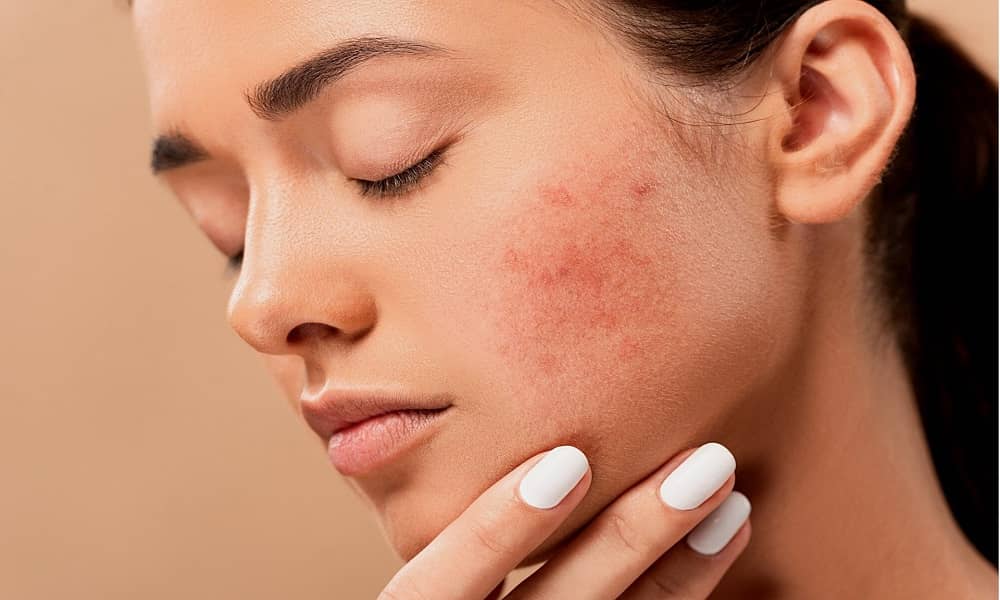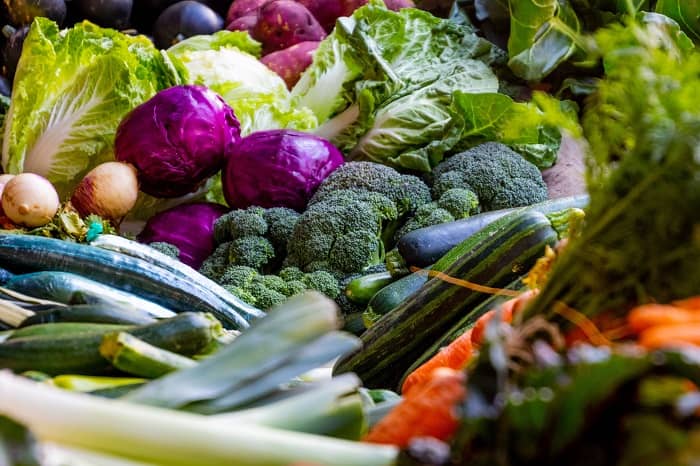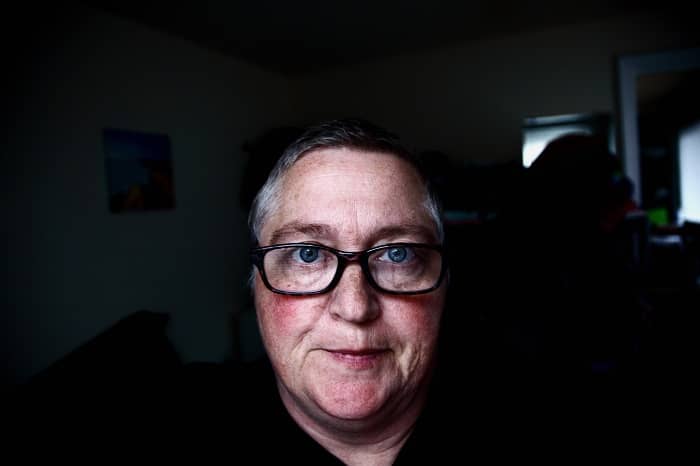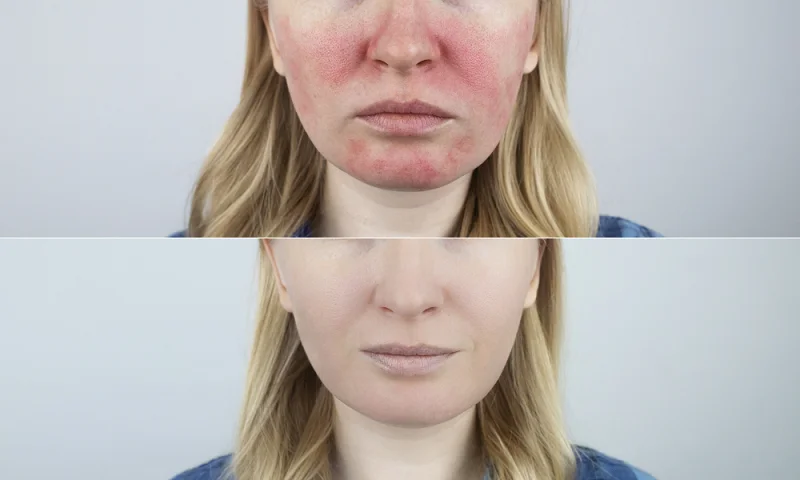


14 Jun How to Treat Rosacea W/ Diet and Over the Counter Medications
Topical treatments and easy dietary fixes are the most practical at-home remedies to relieve rosacea symptoms.
Rosacea is a chronic skin condition causing excessive redness and bumps along with other uncomfortable symptoms. In general, it affects your overall appearance, lowering your confidence.
To top it off, the skin condition has no absolute cure. This factor alone might make it a misery to go through having it on a constant basis. However, with some available treatment, you can relieve the symptoms and lessen the severity of the skin condition.
Considering the painful symptoms of rosacea, even being able to lessen the severity of its appearance offers a huge sense of relief sometimes.
So, here, we’ve shared some of the top ways on how to relieve rosacea symptoms. Let’s start with medical treatments.
How to Relieve Rosacea Symptoms?
Rosacea is a grossly common skin condition, and that’s why there are many such treatments that have proven to relieve the symptoms through trial and error over time. This, in the long run, decimates the bumps, redness, and other signs.
Most Commonly Recommended Rosacea Treatments
- Brimonidine (Mirvaso): It’s a gel that tightens blood vessels present underneath your skin to reduce redness.
- Azelaic acid: A foam and gel help in cleaning bumps, redness, and swelling in the skin condition.
- Metronidazole (Flagyl) and doxycycline: The antibiotics aids in fighting off bacteria present on the skin to reduce swelling and redness.
- Isotretinoin (Amnesteem, Claravis, and others): A popular acne drug that helps in clearing skin bumps. Pregnant women may look for alternatives as they can lead to birth defects.
These rosacea medications are by far some of the best treatments for rosacea. However, it will take some time to get results by using these medicines. They naturally improve your skin condition. In fact, before and after rosacea pictures show how some of these treatments are immensely helpful.
There are also some other OTC rosacea treatments in the market promising good results in relieving redness and inflammation.
Other Medical Rosacea Treatments
For intense rosacea, your dermatologist may recommend some of these procedures to treat your rosacea:
- Laser Treatment: It utilizes intense rays to remove bigger blood vessels to relieve the symptoms.
- Dermabrasion: The rosacea treatment exfoliates and removes the top layer of skin.
- Electrocautery: It is an electric current zapping down the damaged blood vessels.
These rosacea treatments have lasting results, but they are a bit expensive. This factor makes them largely inaccessible to most of all rosacea sufferers.
In that case, certain inexpensive topical treatments can also deliver results in a shorter time period.
For the long-term prevention of outbursts, changes in diet have also been proven quite useful.
How to Relieve Rosacea Symptoms with Dietary Changes
We are what we eat.
Not only does it apply to our physical wellness but our skin health as well. You can ask a dietician, if you can, for a specific rosacea treatment diet.
Else use the following list to get started and bring a few changes in your eating habits on your own.


#1. Turmeric
Turmeric has natural antibacterial properties. Interestingly, it is widely used in Ayurveda for various skin ailments.
Rosacea patients find it effective in reducing skin conditions.
You can either have turmeric-flavored coffee or add the ingredient to your meals. Turmeric rosacea results are impressive. So, don’t miss out on your chance of getting most of the best rosacea treatment.
#2. Cruciferous Vegetables
Veggies containing sulfur are good for skin conditions as well as joints and bones. These foods mainly include cabbage and broccoli.
People who usually didn’t have the vegetable, when started taking it regularly, found a gradual but visible difference.
#3. Avoid Wheat
For some, sugar and wines are key triggers. Sidelining grains, sugar, and wines from your diet may provide substantial results.
This includes the long list of packaged food items having these ingredients. Indeed, it is one of the best natural ways on how to help treat rosacea.
#4. Go Gluten Free
Some rosacea cases can get triggered by gluten and wheat. Food allergy tests can find your triggers as well.
Thus, having a gluten-free diet, in this case, can restore your skin to normalcy. Also, it may reduce the redness, red blotches, pain, and other symptoms of rosacea in a couple of days.
#5. Reduce Sugar Intake
The current lifestyle and unhealthy diet are key instigators behind the increasing health issues. One of the key reasons is the use of sugar in almost everything.
In fact, some have noted a substantial difference in the severity of rosacea symptoms with serious sugar reduction in their diet. And not only it includes sweets, candies, chocolates, and other sugary foods, but good fruit sugar as well.
Also, avoid citrus fruits and chocolates as they contain histamines that may trigger rosacea outbreaks by causing the blood vessels to dilate.
#6. Avoid Allergens
Some skin types are sensitive to certain foods. Thus, it’s advisable to undergo allergy tests to find out your triggering foods.
Once you have identified the triggers, eliminate them from your diet. In a short while, you will encounter improvement in the condition of rosacea.
Additionally, stop using moisturizers, face washes, or any cosmetic product with harsh ingredients. Instead, try water-based organic products.
Also, exclude nightshades from your diet: no more potatoes, tomatoes, peppers, chili powder in any form or quantity, processed or whole.
While preparing your rosacea treatment diet, keep these dietary changes in your mind. A food journal can be a useful way to track your diet and the ingredients you use.
And don’t forget to take note of the specific ingredients and dishes that may cause flare-ups so that later you can eliminate them from your diet.
How to Improve Rosacea [4 Tips]
Stay mindful of these:
- You have to be realistic about the results
- Triggers aren’t always avoidable
- Triggers aren’t the same for everyone
- Consult your dermatologist if the symptoms are severe



In this section, we have shared certain tips with the help of experts on how to relieve rosacea symptoms.
Tip #1: Be Realistic About Results
Rosacea doesn’t have a permanent cure. Still, certain changes may relieve rosacea symptoms.
It can significantly lessen the inflammation, redness, flare-ups, bumps, and red blotches. Moreover, it’s important to pick the right rosacea treatment cream with moisturizing properties. Also, work on your diet to improve the condition naturally.
Tip #2: Triggers Aren’t Always Avoidable
It’s good you have identified a trigger for your skin condition. Eliminating those from your diet makes you feel like having control over the condition. However, things do not always go according to your choices, specifically if you are a person who eats out a lot.
Unless you cook all your meals, it is certainly impossible to skip the triggers. A little carefulness at times may help. When eating out, keep it in moderation to minimize the symptoms of rosacea.
Tip #3: Triggers Aren’t the Same for All
It’s not one-size-fits-all. Triggers for rosacea differ with individual cases. Obviously, there are some common foods triggering rosacea flare-ups. These may be cheese, tomatoes, coffee, spicy foods, alcohol, and chocolate.
However, some of these might not be a trigger for everyone. Thus, it’s better to prepare your own food chart and determine triggers for your skin condition. Certainly, this will help solve the problem effectively in individual cases.
Tip #4: Consult Your Dermatologist
Whatever your skin condition may be, only a dermatologist can handle it effectively. In fact, experts recommend getting a rosacea treatment from an expert to lessen the symptoms.
In case the diet and at-home treatments don’t work for you, it’s time to look for broader skin treatment for rosacea. First, go for evaluation by a board-certified dermatologist. Afterward, choose the suitable treatment offered.
How to Treat Skin Rosacea | Proper Skin Care Routine



There are a lot of things triggering the skin condition. It necessarily need not be food alone.
Sometimes, the rosacea outbreak may be because of an external factor. Keep a daily journal to trial your activities to find out the key instigators.
Be mindful of these common triggers to treat skin rosacea:
- Wind Stress
- Alcohol
- Sunlight
- Hot baths
- Intense exercise
- Hot or cold temperatures
- Hot or spicy foods or drinks
- Medications including blood pressure drugs or steroids you put on your skin
Besides, you should also follow some tips for proper skincare when struggling with rosacea.
Skin Care Routine for Rosacea
Certain changes in your skincare routine relieve rosacea symptoms effectively. These include:
- Apply sunscreen each day
- Be gentle with your skin and don’t use harsh products
- Cover up and stay indoors during hot days
- Keep your face moisturized
- Massage face lightly to release toxins through lymph nodes
- Use an eyelid cleaner if rosacea causes eye irritation
#1. Sunscreen
Use a sunscreen cream with a broad spectrum (blocks UVA and UVB rays) protection. This means it should be SPF 30 or higher with a sufficient PA rating. Also, wear a wide-brimmed hat to cover your face and protect it from the damage caused by sun rays.
#2. Use Only Gentle Skin Care Products
Skip cosmetic products with alcohol, fragrance, and other harsh constituents. Instead, switch to gentle skincare products. After washing your face, use a soft cloth to dry it.
#3. Apply a Moisturizer
Applying a moisturizer is a must. It prevents the damage caused by low temperature and wind which can make your skin dryer.
A moisturizer keeps skin from getting dry and scaly all through the year. In addition, you can add a daily treatment face serum for immediate and long-term rosacea relief.
#4. Massage Your Face (Apply Light Pressure)
Gently run your fingertips on your skin in a circular motion. Begin from the middle portion of your face and move to the ears. This will help the blood vessels to function normally and release toxins.
#5. Cover Up
You can apply a green-tinted cover-up on your skin to hide damaged blood vessels and redness.
#6. Go Indoors
Staying out in the sun for long may damage your skin. So, avoid outside heat by staying indoors in a colder temperature room during the summers.
#7. Care for Your Eyes
Usually, rosacea makes eyes red and causes irritation. Use an eyelid cleaner or a watered-down baby shampoo to gently clean them off.
Besides, switching to a whole new anti-inflammatory diet may work. People with rosacea have benefited from a Mediterranean diet.
It’s also necessary to take note of your emotions and mood swings along with skin ailments. Most feel embarrassed, which affects their self-esteem and confidence.
Thus, consulting with a doctor or a counselor might make you feel better. If it’s affecting your mental health, you can join a support group and discuss your journey and what you are going through.
FAQs
We have discussed all the available solutions on how to relieve rosacea symptoms. Now, it’s time to answer a few common questions asked by readers regarding this common skin condition.
Q1: Can rosacea go away on its own?
Rosacea is a skin condition that can last for decades. Generally, it doesn’t go away on its own.
But in cases of no treatment, it may worsen over time.
You can have bigger red blotches, more inflammation, and other symptoms aggravated. Also, it’s likely to cause permanent skin damage. Thus, you do have to do something and take preventative measures.
Q2: Does drinking water help rosacea?
Drinking water limits the vicious symptoms of rosacea. While it may not completely end the skin condition, it will lessen the redness in the long run.
Not to forget, the human body is made up of water. So, when you drink more water, it helps eliminate the excess toxins present on your skin and in your body.
Q3: What aggravates rosacea?
Basically, certain things cause rosacea to increase. They are referred to as triggers. The triggers may vary from person to person and they may even be common among folks.
The most common rosacea triggers are sunlight and hairspray. Other common triggers are certain foods, stress, heat, alcohol, and spicy foods.
Q4: What vitamins are bad for rosacea?
Deficiency of certain nutrients may worsen rosacea symptoms. So, we can’t find any vitamins that are bad for rosacea.
Instead, the lack of these nutrients may work as a trigger. Lack of Vitamin B6, Selenium, and Magnesium leads to the dilation of blood vessels, particularly on the cheeks and nose. The deficiency of Vitamin B12 may result in the same.
Q5: Are bananas good for rosacea?
People sensitive to histamines can get a rosacea flare-up from bananas.
Apart from that, citrus fruits, nuts, tomatoes, and beans have similar effects. Still, they might not have a similar impact on everyone. So, you can have some of the foods in this category, this may be bananas as well.
We recommend asking your dietician or dermatologist for specific suggestions.
Q6: Are eggs bad for rosacea?
No!
Foods with anti-inflammatory effects may improve rosacea. This means such foods help improve redness, swelling, and blotches caused in the skin condition. Also, foods rich in omega-3 fatty acids may have similar effects.
Eggs are one such food. So, they aren’t bad for your skin condition, and they may help in relieving the symptoms with their anti-inflammatory effects.
Q7: Is Vitamin C good for rosacea?
When it comes to treating rosacea symptoms, vitamin C provides magical effects. It strengthens capillaries. And the fewer are the broken capillaries, the lesser is the redness. In short, it helps to relieve the general symptoms of rosacea effectively.
Q8: How do you calm down rosacea at home?
Here are five steps to treat rosacea at home:
- Use a daily gentle redness-reducing cleanser.
- Skip alcohol-based products and perfumed soap.
- Let your face dry naturally or blot your face dry.
- Apply a sunblock, which contains an SPF (sun protection factor) of at least 30, and wear a hat.
- Moisturize your skin each day with a good-quality moisturizer.
Q9: What foods make rosacea worse?
Five common foods that trigger rosacea are:
- Dairy
- Alcohol
- Spicy foods
- Hot beverages
- Foods with histamine in them
Q10: What products to avoid with rosacea?
Top products to avoid with rosacea are:
- Alcohol
- Menthol
- Camphor
- Fragrances
- Peppermint
- Witch hazel
- Eucalyptus oil
- Propylene glycol
Q11: What are the types of rosacea?
The four types of rosacea include:
- Subtype one or Erythematotelangiectatic Rosacea (ETR): Usually, it causes flushing, facial redness, and visible blood vessels.
- Subtype two or Papulopustular (or acne) rosacea: It results in acne-like breakouts and is more likely to affect middle-aged women.
- Subtype three or rhinophyma: It’s a rare skin condition that results in thickening of the skin on your nose. Typically, it affects men and accompanies another subtype of rosacea.
- Subtype four or ocular rosacea: The symptoms of the skin condition center around the eye area.
Q12: What are the common symptoms of rosacea?
The common signs and symptoms of rosacea include:
- Larger pores
- Problems seeing
- Bumps on your eyelids
- Patches of rough, dry skin
- A swollen, bulb-shaped nose
- Stinging and burning of your skin
- Broken blood vessels on your eyelids
Q13: When to see a doctor?
If you experience rosacea inflammation and it gets severe, it’s time to check with a skin specialist (dermatologist). At this point, you should go for a proper diagnosis and treatment.
Q14: What is the main cause of rosacea?
Various factors can trigger rosacea flare-ups. These include:
- Exercise
- Emotions
- Sunlight or wind
- Temperature extremes
- Various cosmetic products
- Hot drinks and spicy foods
- Red wine and other alcoholic beverages
- Drugs that dilate blood vessels, including some blood pressure medications
So, if you already have rosacea, it’s crucial you avoid these triggers whenever possible.
Final Words
This was our guide on how to relieve rosacea symptoms. All the mentioned tips and tricks will help you reduce the redness on your skin in the long run.
Experts recommend changing diet and skincare routine to support the treatment accordingly. However, leaving the skin condition untreated may lead to severe complications requiring surgical treatment.
Remember rosacea doesn’t have any cure. The only way is to bring lifestyle changes to reduce the symptoms over time.



No Comments